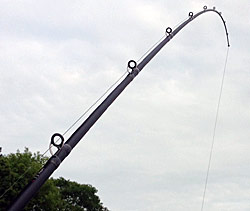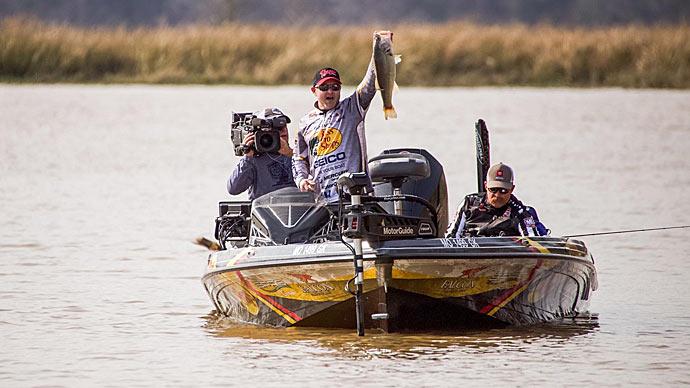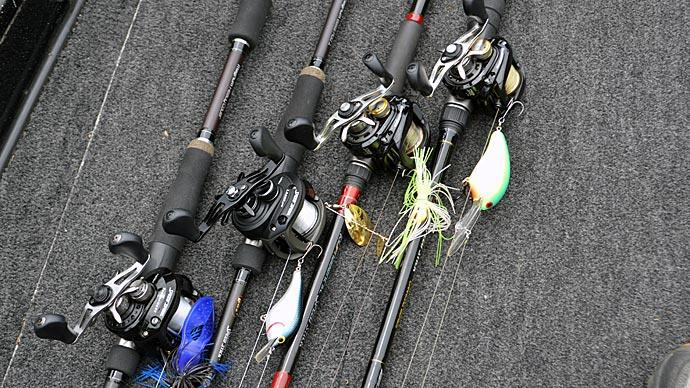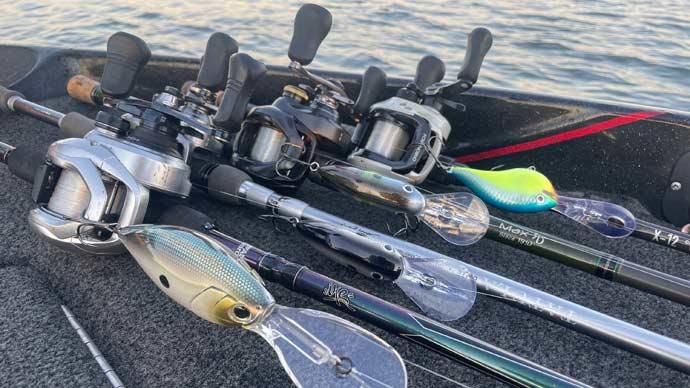
Sit down with a cup of coffee, tea, or soft drink, and really look at your equipment. Determine which rod and reel is your favorite, then ask yourself why you like that combination. Each rod and reel has a particular function. You can't use a heavy-action rod to cast topwater baits and expect to get the reaction needed from the bait to catch fish. Examine your rods carefully. Are they the correct type of rods for the way you really fish?
First, are all your rods a comfortable length for you? If you are built lower to the ground than 5' 5", a 7-foot rod will be difficult for you to use all day. Try downscaling to a shorter rod and you will find enjoyment in flipping, casting, or spoon fishing. Also when the day is over, you will not feel as tired.
Today's rods are designed to improve the angler's feel of biting fish. The rod shaft is called a blank. When a rod is manufactured, the blank is formed using graphite, fiberglass, or other material. The actions of these blanks are called light, medium, medium/heavy, and heavy. The action of the upper end of the blank, called the tip, can be regular, light, and extra light. When the blank has been assembled, i.e., the guides and handle have been attached, the end result is called a fishing rod. Thus, whether you fish with a baitcasting or spinning rod, the action of the rod refers to the blank. This information is meaningful when you decide what type of fishing you will do.
The number of guides (eyes) on your rod is important. They help transmit line signals to the rod so it is easier to feel the fish. The types of guides available today have changed. Some guides have ceramic rings inside the outer metal frames. Other guides have silicone carbide, aluminum oxide, gold aluminum oxide, or chrome plated insert inner rings. All of these types are claimed to help reduce the friction that causes fraying or nicks in your line. Again, it is your personal experience or preference as to which type of guide you want.
Handle length is important to consider before you purchase a rod. Also, the material of the handle, whether cork or foam should be thought about. Will your wet hands slip off, dropping your rod into the deep blue?
Think of the action of an oak tree when the wind blows. The outer limbs of the tree move easily in the breeze, the trunk will sway when the wind is strong. The roots only move when tornadoes hit or they're dug up.
Light action rods are not normally used to fish for bass, mainly because you need the strength of the blank to move a bass out of cover.
Baitfish will chum, pop out of the water, and make frantic moves to avoid being eaten. You want to duplicate this live action with your bait, so you use an extra fast action tip with a medium or medium/heavy action rod. This particular combination gives you the backbone needed and the flexibility to catch fish using topwater baits. With the flick of the wrist, the rod tip will move the line quickly, pulling the bait over the water. The handle of this rod is important, too. It would be difficult to use a long-handled rod when attempting to flick the bait on the water, so try using a trigger handle when topwater fishing.
Medium or medium/heavy action rods with fast tips are used when fishing crankbaits, spinnerbaits, and depending on the structure and vegetation, some plastic baits. The pulling of the line under water requires more power than topwater fishing, but not the horsepower of a heavy action rod. Use a handle on this rod that touches a spot between your wrist and elbow when held in your hand at the reel.
Heavy action with standard tip rods are used when fishing dense cover such as reeds, bushes, deep grass beds, or heavy timber. This rod allows you to set the hook and get the fish out of these types of structures with more strength. The handle of this rod should be long enough to reach your elbow. The reason for using this type of handle is it gives you the leverage you need when you set the hook on a fish.
The guides on your rod are important. Be sure to check them before you go fishing. If any are bent, straighten them out because the line will not flow through them correctly. Take a Que-tip and turn it in the inside of the circle of the guides. If any cotton sticks to the circle, have the guide replaced before you use the rod again. If you do not, the line will fray or have nicks in it and will break when you set the hook on a fish. When purchasing your next rod, pay particular attention to the wrapping attaching the guides to the rod. If the wrapping is not sufficient, the guides will become loose and need replacing.




